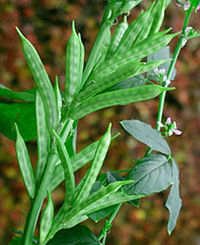
Photo from wikipedia
ABSTRACT Dry guar (Cyamopsis tetragonoloba L. Taub) seeds are primarily used to extract galactomannan gum for oil fracking, however, the immature pods are used as a vegetable in India and… Click to show full abstract
ABSTRACT Dry guar (Cyamopsis tetragonoloba L. Taub) seeds are primarily used to extract galactomannan gum for oil fracking, however, the immature pods are used as a vegetable in India and sold in ethnic grocery stores in the Atlanta, Georgia area. Nineteen guar genotypes were grown in the field at Griffin, GA, USA for two years (2010–2011). Since the determination of flavonoid concentration would add value to the guar accessions for use as a functional food vegetable, immature guar pods were evaluated for flavonoid concentration. In this study, the immature pods from these 19 guar accessions were analyzed for flavonoid concentration using high-performance liquid chromatography. Several accessions including PI 253182, PI 262152, PI 263698, and PI 288357 showed significantly greater daidzein concentration than all three controls based on seed production in 2010. However, PI 179926, PI 180434, PI 182969, PI 183400, PI 253182, PI 262152, PI 263882, and PI 263897 exhibited significantly greater genistein concentration than the second and third best controls in 2011. Both PI 180434 and PI 288359 produced significantly higher kaempferol concentration than the third best control. Daidzein concentration was significantly correlated with genistein concentration (r2 = 0.47*) for both years. Luteolin concentration showed a significant negative correlation with genistein (r2 = −0.45*). Quercetin concentration significantly correlated with kaempferol (r2 = 0.854***) and genistein (r2 = 0.455*) concentrations. The accession, PI 542608 was observed to contain high concentrations of kaempferol and quercetin in the cluster analyses. These results will help plant breeders develop guar cultivars with superior flavonoid concentrations.
Journal Title: Journal of Dietary Supplements
Year Published: 2017
Link to full text (if available)
Share on Social Media: Sign Up to like & get
recommendations!